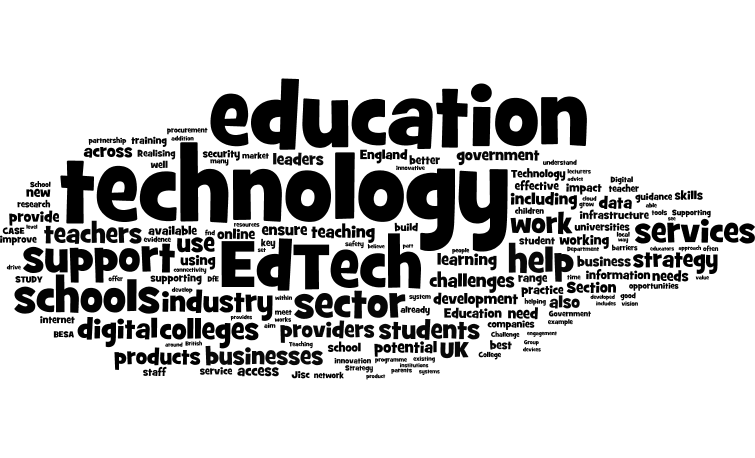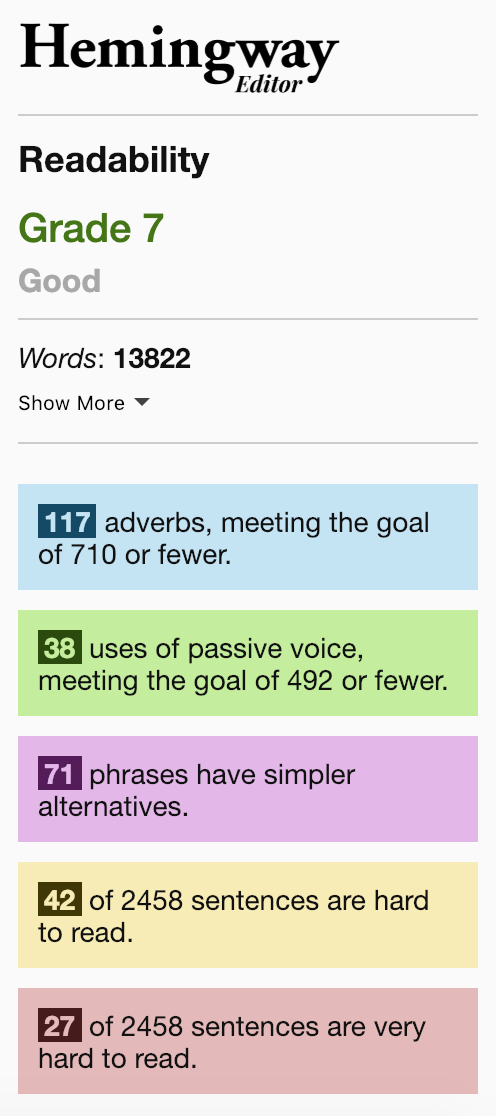PLUS: Introducing the new SnoreMaster Award! More details below.
The Ed Tech Strategy
A pictorial summary of the ed tech strategy
Here's a pictorial summary of what I think of the DfE's new ed tech strategy:
The new ed tech strategy by Terry Freedman
A textual analysis of the ed tech strategy
DfE wordle of the ed tech strategy, by Terry Freedman
Hemingway analysis of the ed tech strategy, by Terry Freedman
A quick recap…
Here's the news part in a soundbite: the Department for Education in England recently launched its education technology strategy, called Realising the potential of technology in education.
My thoughts on the strategy
Much has been written about this already, and I'll provide a few links at the end of this article. I think the first thing to note is that I'm tempted to echo Dr Johnson's comment about a dog walking on its hind legs: "It is not done well; but you are surprised to find it done at all."
It's been a really hard slog to get the governments since 2010 to see any potential in education technology at all, so from that point of view I suppose this is a step in the right direction. However it suffers from a number of drawbacks.
First, if you look at the word cloud of the document in the word cloud above, you'll notice a marked absence of the word "learning". In fact, I think it appears four times in the strategy, mostly in the context of online learning. Students hardly make an appearance. The word "education" comes up a lot, as does the word "technology", and that leads us on to the next problem.
The second problem is that it is very much technology-driven. Indeed, the document reads like a love letter to industry.
Thirdly, the document would carry more authority if it wasn't recommending several things that the DfE (albeit under a different Education Secretary) had already got rid of. I'm not sure that the current Education Secretary or the education technology team advising him even know what was in place a few years ago. Maybe I'm doing them a disservice, but in my experience of organisational amnesia the DfE and its advisers have the worst memory of all: nobody seems to know anything that happened before they came on the scene.
Fourthly, as all of the above has been covered by others, and in greater depth, I was rather more interested in a curious phenomenon: why is the strategy so unutterably boring to read? I ran it through a textual analysis app called Hemingway, the results of which you can see in the screenshot above.
Hemingway and clichés
Surprisingly, there are not many passive sentences according to Hemingway. Passive sentences (such as "It was written by me" rather than "I wrote it") tend to suck the life out of any piece of writing, but there aren't enough of them in the strategy document to account for its high snore quotient.
So I went through it with a fine tooth comb, and it all seems to come down to two (related) linguistic approaches. One is to use clichés, and the other is to make liberal use of awful corporate jargon. Thus we get meaningless drivel which is more likely to be heard from the mouths of corporate PR people who have little to say, and are doing their best to disguise the fact, than it is from anyone who works in education.
We get off to a bad start in the Foreword, a kind of introductory letter from the Education Secretary, which includes the observation that Britain is punching above our weight:
"At the same time, we have a flourishing EdTech business sector, punching above our weight internationally and with a steadily growing export market."
Well, according to Investopdeia in 2018 Britain was the fourth largest economy in the world, so it would be rather surprising if we did not have a thriving edtech industry.
That's the least of the issues though. The document is riddled with dreadful words like 'drive', 'deliver' and so on. Here are a few examples:
"...up a new EdTech Leadership Group made up of representatives across the education sector (including academia) and industry to continue to drive this agenda forward."
"We have prioritised challenges that tackle known issues faced by the education sector, those that have the potential to reduce teacher workload, improve pupil outcomes or generate cost savings and which will help to drive long term culture change."
"Supporting the continued development of a dynamic UK EdTech business sector will also be crucial to delivering our ambitions."
"To support the type of coordinated sector leadership that is a feature of other more established business sectors, the DfE and the Department for Business, Energy & the Industrial Strategy (BEIS) will establish an EdTech Leadership Group, that will ensure that both the business sector and the education sector are able to drive the delivery of this strategy across England."
"We will be building on the experience of other government innovation funds, such as the Defence and Security Accelerator and the GovTech Catalyst, as well as drawing on the expertise of industry and the education sector and will work with a range of organisations to deliver the challenges." (Why anyone would want to deliver a load of challenges is beyond me; solutions would be preferable.)
"Of the 200+ digital services that we provide directly, we have already transformed a number of these to deliver user-centred and streamlined online customer journeys…" (I think I know what this sentence means, but I'm not 100% sure.)
"Through transforming our services, we will role-model existing good practice standards for digital technology and services and take a user-centred approach to delivery." (Note that “role-model” is a noun, but is being used here as a verb.)
Here's an acid test: do you for one moment believe that this guff was written by anyone actually working in education, 'at the chalkface', to use another cliché? When was the last time you heard a teacher speak like this?
"Morning, Fred. Ready to try and pummel some knowledge into our customers this sunny day?"
"Indeed, headmaster. I have adopted a user-centred approach in order to deliver my challenges in the classroom, and in so doing to drive forward the agenda."
"Great! Fancy a cup of tea?"
Whoever wrote the document probably consulted Lucy Kellaway's Guffpedia website.
Why style matters
Does this actually matter? I believe it does, for the following reasons.
First, the style of any document should be appropriate for the target audience. Who is the target audience for this document? it can't be teachers, because teachers don't use terms like 'driving the agenda'. Headteachers? I doubt it. Executive Headteachers who have never worked in a school before? Possibly. Industry people such as CEOs? It reads like it. Or perhaps the target audience was the writer's line manager; after all, you can't go wrong if you put in some tried and tested expressions using the words 'drive', 'deliver' and 'challenges'.
Secondly, the document is boring, and that's a problem for two reasons. For a start, how on earth does anyone manage to make a document about education technology boring? It takes a certain talent I think. Indeed, it should be rewarded through a set of snoremaster awards. In fact, I might suggest that to the British Educational Suppliers Association and Bett as a new category for the annual Bett awards. In the meantime, I've created my own SnoreMaster Award -- see below.
Also, given that there's a teacher recruitment and retention crisis in the UK (as most other places), every document emanating from the DfE should have teachers on the edge of their seats, thinking "This is definitely the right job for me!" In other words, the DfE should drop the corporate BS and put some passion into their policies.
Recommendations to the DfE
Identify who your target audience is.
Use language that is appropriate to your target audience.
Avoid using clichés.
Avoid using corporate BS jargon.
Try to inject some enthusiasm or even passion into your documents.
Recommendations to teachers and others
Focus on the positive aspects of the strategy, which are:
The fact that it’s been written.
It shows that the DfE is not only aware of technology that came after the quill, but is positive about its use.
It acknowledges that technology can be used to reduce teacher workload.
It sets out a number of challenges.
It commits itself to a number of targets.
It contains several case studies.
It states the government’s commitment to ed tech, including a try-before-you-buy scheme called LendEd from BESA.
Further reading
For analysis of why the content of the strategy, rather than the style, leaves much to be desired, read the following:
The DfE Edtech strategy -- abort, retry fail? by David Kernohan.
Finally 'realising the potential...'? by Tony Parkin.
The DfE's ed tech strategy: better late than never? by Terry Freedman
Introducing the new SnoreMaster Awards
With a Snore Quotient (SQ) of 98%, the DfE's new ed tech strategy is an outright winner of my new SnoreMaster Award. This is given on the basis of an SQ, decided by a complex algorithm based on the length of the document, time of day, how long it takes me to fall asleep reading it, and how long it takes someone to wake me up afterwards.
It takes the form of a Snore Rating, with 1 Snore being the lowest (and therefore the best, or least bad), and 5 Snores being the worst.
Taking into account all the factors mentioned, I'm delighted to award the ed tech strategy a 5 Snore rating.
A slightly different version of this article was published in the Digital Education newsletter.





